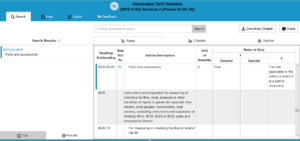You’ve gotten your product manufactured overseas and managed to save a few bucks too by doing it across the water. Great. But that’s only the first (admittedly large) step. The next big challenge is shipping the product back to the U.S. without losing all those saving to unexpected high import duties. Amongst the current political talk regarding trade, it is more important now than ever to pay close attention to how the import process can affect you and your goods.
What is an HTS Code?
HTS refers to the Harmonized Tariff System or the Harmonized Tariff Schedule of the United States (HTSUS). It is a database resource that is used to classify goods imported to the U.S. and to determine their tariffs. The HTS consists of countless numerical codes associated with a description and a duty. Goods are assigned a code based on their descriptions, and importers are then charged the appropriate duty.
Codes are determined by factors such as final product category, applications, manufacturing process, materials, supplier type/country, and other descriptive details. You can reference the HTS online (http://hts.usitc.gov) to lookup appropriate codes, related customs duties, and any applicable rule or regulations for your item. However, duties are changing all the time and it is Customs and Border Protection (CBP) who makes the final ruling as to what the correct duty rate is.

The HTS can be very complicated, which is why thorough product descriptions are important. If your product description is incomplete, this can lead to a classification that is incorrect and the error can be costly. Duties can be vastly different across codes with similar descriptions and you may incur an unplanned for charge from customs if you are not careful.
For example, let’s say a company had CNC machined aluminum parts produced in China. The company provided their Chinese factory with engineering drawings that described the parts as “aluminum housing”. When it came time to ship the product out from China through FedEx, the factory used that same description of “aluminum housing” on the invoice. Two months later, Customs called upon the U.S. buyer to unexpectedly pay an extra $10,000 for anti-dumping AD and CVD fees for the imports.
What happened? Since the description of the parts was somewhat vague and incomplete, the wrong HTS became associated with the import. These product parts were intended to be used as an “enclosure of semiconductor equipment controller”, which falls under HTS code 9025.90.0600. This code is duty free. However, upon arriving at U.S. customs, the U.S importer (someone at FedEx) incorrectly used HTS code 7616.99.5190. This code is for aluminum brackets for home and housewares products such as window frames or carpet fixtures, which fall under the anti-dumping(AD) and countervailing duty (CVD) act that results in a tax. The original description of “aluminum housing” on the factory invoice lead to a misunderstanding with the FedEx importer who guessed these products were for houseware use.
With the vastness and complexity of international logistics, these type of situations can occur behind the scenes without your awareness, until you are unexpectedly charged.
Here are a few tips to consider to help lessen your chance of unanticipated tariffs:
- Provide a thorough and complete product description to your factory and everyone in between. The more information provided, the less chance for misunderstandings and the better chance for accurate information to be passed along. Be detailed in what the product looks like, materials it is made of, the type of product it is, how/what it is meant to be used for, and any other descriptors to distinguish it. Remember, there are a lot of people, such as shipping agencies, government employees, and boarder control personnel who are handling your import process and they may not know your business or product at all. Making it very clear is critical.
- Utilize a customs broker or import specialist. If the rate of duty might make or break your decision to import, it’s best to get the most accurate estimate of it that you can. If you are not confident in your understanding of the system, get someone who has expertise in the field to help. But remember, a broker’s decision isn’t final — CBP will still make the final call.
- Consider the effects of adjusting your manufacturing process and packaging method. It is considerable to note that changes in the way you package your product for shipment could affect how customs views your goods. For example, importing fully assembled products versus importing pieces and assembling in the U.S. may change how CBP categorizes the goods. And of course there’s a chance these different codes will have different duty rates. Parts may be subject to high duties, whereas assembled products or full kits could be zero duty. While making changes like these may have benefits for other areas of your business, don’t forget to also consider how it could affect your import procedure. It may sound strange, but that’s the way the laws were written when they went through multilateral negotiations by different interest groups in Congress.
When all is said and done, there is no sure way to guarantee you will end up paying the import duty you expected. Sometimes there is no clear choice for which HTS code a product should belong to, especially for a completely new type of product. It can come down to opinion and whether you or customs can make a better case for your chosen category. And that final classification determination can either save you money, or cost you.

